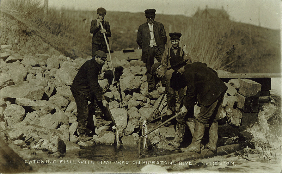|
On June 1st, 1881, the
first sod in the Pipestone region was turned by William Lothian working
for Mr. Dan McKinnon and a little later he sowed by hand seven acres of
barley, the initial cultivated field and crop in the district.
James Lothian, accompanied by his brother William, arrived in the
valley of the Pipestone Creek on May 30,1881. Two days before, on
Saturday May 28, Dan McKinnon and A. McLean had arrived. These four
were the first white men to settle in the
Pipestone Valley.
The Lothian brothers were the sons of a Scottish tenant farmer. In
their time most of the farmland was held in large estates and leased to
tenant farmers on long leases. The Lothian family consisted of seven
sons and two daughters. For young ambitious, hardworking men these
conditions offered little opportunity for prosperity. Britain was in
the depth of an agricultural depression. So James and William, after
much family consultation inspired by the aggressive advertising
campaign for immigrants conducted by the Canadian Government, decided
to emigrate and to take up homesteads in Manitoba.
They arrived in Quebec City in early July 1880 and made their way to
Winnipeg. Then, in order to get a closer look at the land, they walked
to Portage la Prairie. This took them two days. They got work with
Kenneth McKenzie on his farm. eight miles west of Portage and worked
there until late November, in the meantime taking every opportunity to
assess the quality of the land. They spent the winter of 1880 to
1881 in the Riding Mountains on land belonging to Robert Campbell, an
officer of the Hudson's Bay Company. Part of the winter was spent in a
logging camp where they were paid $20.00 each per month and an
additional $10.00 for the use of their team of oxen.
In the spring of 1881, after plowing a portion of Mr. Campbell's land
and sowing some grain, they set out with their team of oxen and a Red
River cart containing all their belongings, to look for land. They were
well-trained farmers and knew how to choose good land. Thus they came
to the Pipestone Valley on May 30, 1881.
Mr. James Lothian was for six weeks during that season the only white
man in the district, all the others being absent for
various reasons, and he has recorded in an old diary how good
the Indians were to him during this lonely time. They brought
him numbers of wild duck, a most welcome addition to his food supply,
in that first season none to plentiful. Later in that same diary he
reported on the first dance held in the new community attended by about
30 people, five of whom were women. Such was social life in those early
days.
William was the first President of the Pipestone Mutual Improvement
Association. He was Reeve from 1899 – 1901. His letters home are
in the Mb. Archives.
In 1882, Annie Milliken, William's childhood sweetheart, came to Canada
from her home in Berwickshire, Scotland, with her sister's family. She
and William were married in Brandon the following year and he took her
to her first home, a log cabin he had erected on 20-7-26, the
land he now owned. Annie was the first white bride in the district.
The Lothian family took a very prominent part in the social,
educational and religious life of the community. William was active in
the politics of the Municipality and was Reeve for many years. In
connection with other kindred spirits, the Forkes. Millikens, etc., a
debating society was organized and
some very "lively" discussions followed you can be sure.
Adapted from Trails Along the Pipestone, page 376
Adapted from Pioneers of the Pipestone. page 8

Photo from Manitoba Archives
|





